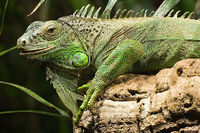Metabolic Bone Disease
Introduction
Metabolic bone disease affects reptiles in captivity, particularly young green iguanas. The condition is caused by a diet low in calcium and high in phosphorous (secondary nutritional hyperparathyroidism), vitamin D deficiency (due to poor lighting), certain toxicities and diseases of the kidneys, liver or rarely, the.
Clinical Signs
Clinical signs include:
- Lethargy
- Inability to support weight
- Rounded skull
- Spontaneous/pathological fractures - particularly the long bones
- Adult animals also show signs of hypocalcaemia such as muscle tremors
- Anorexia
- Dystocia in pregnant females
- Curvature of the spine
- Soft, flat and misshapen shell in chelonia
- Bowing, swelling and shortening of bones - particularly the mandible and long bones
- Impaction - secondary to the ingestion of large amounts of calcareous material, in an attempt to correct the nutritional imbalance
- Small in comparison to litter mates
Diagnosis
As the condition is normally caused by nutritional and management factors it is important to take a detailed history of the animals diet and husbandry.
Radiographs of the patient should be obtained. The skeleton shows reduced density, and pathological fractures may be present, particularly in the long bones of the hindlimbs. Large quantities of radiopaque material may be seen in the intestines following the ingestion of calcareous material.
Haematology and biochemistry should be performed to measure calcium levels and assess kidney function. Renal failure is a common complication and a poor prognostic indicator.
Treatment
Nutritional calcium deficiencies need to be addressed by dietary supplementation (oral/injectable calcium lactate or calcium gluconate ). Management should also be changed, to ensure the animal is exposed to sufficient levels of sunlight and vitamin D. Oral vitamin D supplements are also available to treat this deficiency.
Impaction cases should be treated with laxative such as milk of magnesia or petroleum jelly as this should help the animal pass the foreign material.
Prevention
It is important that owners of reptiles are properly educated with regards to the nutritional and husbandry requirements of each individual species in order to prevent conditions such as metabolic bone disease occurring.
Nutrition
Insectivorous reptiles should be fed a variety of insects such as earthworms, locusts and fruitflies. However as many insects do not provide reptiles with the appropriate calcium:phosphorous balance, supplementation is required. This can be provided by dusting insects with a supplement before they are fed to the reptile, or by feeding the insects themselves a diet with a high calcium:phosphorous ratio for an appropriate time before they are fed to the reptile.
Herbivores should be offered a variety of fresh fruit and vegetables with appropriate levels of calcium, phosphorous and fibre.
Carnivorous reptiles should be fed on lean whole mammals. Providing a reptile-specific dietary supplement is highly recommended in both herbivore and carnivore diets.
Additional sources of calcium include fish, collard leaves, and algae.
Prognosis
If the animal presents with chronic or severe signs, prognosis is poor. Early recognition of the condition and mild signs offer an improved prognosis. Any deformities are unlikely to resolve.
| Metabolic Bone Disease Learning Resources | |
|---|---|
 Test your knowledge using flashcard type questions |
Reptiles and Amphibians Q&A 03 Reptiles and Amphibians Q&A 06 Reptiles and Amphibians Q&A 12 |
References
Divers, S (1996) Basic reptile husbandry, history taking and clinical exam In Practice 1996 18: 51-65
Frye, FL & Williams, DL (1995) Self-Assessment Colour Review - Reptiles & Amphibians Manson
Merck & Co (2009) The Merck Veterinary Manual (Ninth Edition), Merial
Rowland, M (2009) Veterinary care of bearded dragons In Practice 2009 31: 506-511
| This article has been peer reviewed but is awaiting expert review. If you would like to help with this, please see more information about expert reviewing. |
Error in widget FBRecommend: unable to write file /var/www/wikivet.net/extensions/Widgets/compiled_templates/wrt6961cb302a5cb4_28636644 Error in widget google+: unable to write file /var/www/wikivet.net/extensions/Widgets/compiled_templates/wrt6961cb30317a09_41229184 Error in widget TwitterTweet: unable to write file /var/www/wikivet.net/extensions/Widgets/compiled_templates/wrt6961cb30376737_01200882
|
| WikiVet® Introduction - Help WikiVet - Report a Problem |
